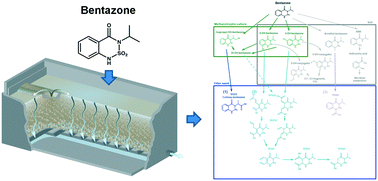Microbial degradation pathways of the herbicide bentazone in filter sand used for drinking water treatment†
Abstract
The herbicide bentazone is used extensively worldwide, and it is frequently detected in groundwater sources used for drinking water production. Previously, bentazone has been shown to be biodegraded in filter sand from biological rapid sand filters at various waterworks. This untapped potential could be an inexpensive and sustainable alternative for the removal of trace organic contaminants. To study the fate of bentazone in sand filters and to identify associated risks, degradation pathways in filter sand were identified and the toxicity of identified transformation products was evaluated using quantitative structure–activity relationship (QSAR) modelling. Bentazone degradation was investigated in microcosm experiments with filter sand, effluent water and bentazone at elevated (5 mg L−1) and environmentally relevant concentrations (<10 μg L−1). The investigations at elevated concentrations revealed up to 10 transformation products, suggesting three main biotransformation pathways: 1) oxidation of the isopropyl-moiety to the corresponding carboxylic acid, 2) oxidation of the aromatic ring leading to ring cleavage and subsequent decarboxylation reactions, and 3) N-methylation followed by oxidation to a carboxylic acid. At environmentally relevant concentrations, 92% of the initial bentazone was removed within 13 days, and at this point only one transformation product, carboxy-bentazone, could be detected in the water. QSAR-models considering both human and environmentally relevant endpoints showed that degradation in filter sand led to a detoxification of bentazone. Initial oxidation processes followed by further degradation, and partial mineralization highlights the relevance of both methanotrophs and heterotrophs for the bentazone degradation in rapid sand filters.



 Please wait while we load your content...
Please wait while we load your content...